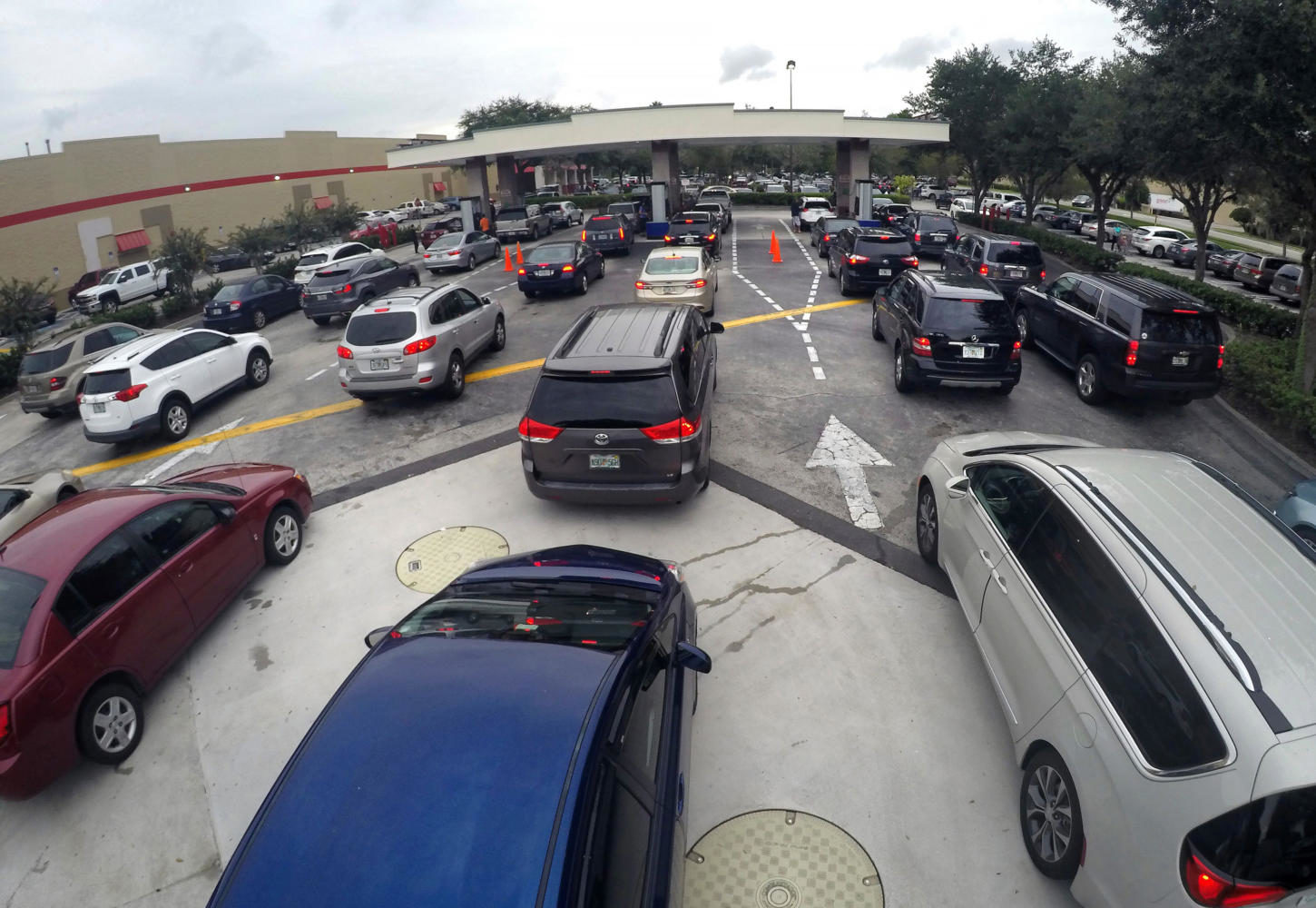Hurricane Irma makes landfall in the northeast Caribbean with Florida likely in crosshairs
Drivers wait in line for gasoline at the Costco in Altamonte Springs, Fla., ahead of the anticipated arrival of Hurricane Irma on Wednesday, Sept. 6, 2017. (Joe Burbank/Orlando Sentinel/TNS)
September 6, 2017
Floridians hit the highways, scrambled for supplies and hammered plywood over windows as a monster hurricane made landfall in the Caribbean early Wednesday, setting a wild, wind-churned course toward Puerto Rico, with the U.S. mainland in its sights, likely over the weekend.
Hurricane Irma, one of the most powerful Atlantic hurricanes ever, wreaked havoc on a string of small islands with drenching rainfall and howling 185 mph winds on a track toward South Florida, where Gov. Rick Scott begged constituents to obey calls to flee the storm’s path when the time came.
“Please do not ignore evacuation orders,” Scott tweeted. “Remember, we can rebuild your home, not your life.”
Advertisement
In warning of the dangers, the governor invoked Hurricane Andrew, which devastated Florida a quarter-century ago, causing massive destruction and killing nearly 50 people.
“I want everybody to understand the importance of this — this is bigger than Andrew,” Scott told ABC News.
President Donald Trump declared states of emergency in Florida, Puerto Rico and the U.S. Virgin Islands. Florida began activating its National Guard, with 7,000 members told to report for duty Friday. A state of emergency has been declared for all 67 Florida counties.
As he did while Hurricane Harvey pounded Texas late last month, Trump unleashed tweets about the storm’s strength. “Hurricane looks like the largest ever recorded in the Atlantic!” he wrote Wednesday morning on Twitter.
The president also said his “team” was ready in Florida, adding: “No rest for the weary!”
The National Hurricane Center said the storm, was one of the five most powerful Atlantic hurricanes in the last 80 years and the strongest Atlantic storm on record outside the Gulf of Mexico and the Caribbean Sea.
By late morning Eastern time Wednesday, the storm’s eye was about 65 miles east-southeast of St. Thomas in the U.S. Virgin Islands and about 140 miles east of San Juan, Puerto Rico, heading west-northwest at 16 mph, the weather service said.
Advertisement*
Satellite imagery of the enormous storm inspired fear and awe. The hurricane center in Miami described a vast swirling mass, with hurricane-force winds extending 50 miles from the storm’s center.
The hurricane’s force was such that it was detected by earthquake-measuring equipment on islands it passed, said Stephen Hicks, a seismologist at Britain’s University of Southampton.
Before dawn Wednesday, the tiny Caribbean island of Barbuda was pummeled by wind and rain as the Category 5 storm passed almost directly above it, tearing off roofs, uprooting trees and triggering floods. In neighboring Antigua, many sought safety in government shelters as the winds turned storm-borne debris into missiles.
Irma also roared past the French islands of Saint Martin, wrecking a government headquarters, and Saint Barthelemy, knocking out power and flooding buildings including a fire station, The Associated Press reported.
Six southern islands in the Bahamas were under evacuation orders, Prime Minister Hubert Minnis said, with people being flown to the capital, Nassau.
In Puerto Rico, people hunkered down as the hurricane menaced the U.S. territory, with the height of winds and rain expected later Wednesday. Gov. Ricardo Rossello said the storm’s danger was “like nothing we’ve ever seen.”
With Puerto Rico’s infrastructure already tottering, islanders were bracing for a loss of power that could linger for weeks or even months.
In the low-lying Florida Keys, where many people are accustomed to riding out hurricanes, mandatory evacuation orders were in effect for visitors and were expected to be extended to residents later Wednesday — a complicated undertaking that was to include airlifting hospital patients.
In Miami-Dade County, authorities urged people to stock up on enough food and water to last three days, and said coastal residents should be ready to clear out if ordered.
Storm monitors reached back nearly a century to provide comparisons, with the weather service likening Irma’s destructive power to that of Hurricane San Felipe, which killed almost 3,000 people in Puerto Rico, Florida and the island of Guadeloupe in 1928.
___
(c)2017 Los Angeles Times
Visit the Los Angeles Times at www.latimes.com
Distributed by Tribune Content Agency, LLC.
Advertisement








